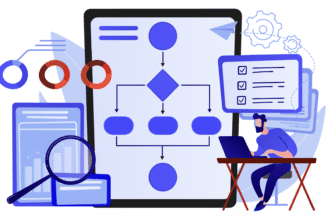If your organization is looking for a modern, AI-infused service desk / ITSM platform — to streamline support, integrate with IT asset management, and scale across departments — ServiceDesk Plus by ManageEngine is a compelling candidate.

It combines ticketing, CMDB, asset management, AI/ML automation, enterprise service management (for HR, facilities, etc.), and many other capabilities — all in a flexible package (cloud or on-premises).
Below, you’ll find a deep dive into everything you’d want to know before choosing it.
What is ServiceDesk Plus?
At its core, ServiceDesk Plus is an AI-driven unified service management (USM) / IT service management (ITSM) solution.
Key value propositions:
- Combines ITSM, ITAM, and ESM (Enterprise Service Management) — meaning support, assets, and departmental service requests (HR, facilities, finance) can be handled with the same backbone.
- Embedded AI / ML features out of the box (in all editions, not just premium ones).
- Available as on-premises or cloud deployments, with flexibility to migrate between them.
- Designed with data privacy/compliance in mind — localized data centers, no trackers or sub-processors.
It presents itself as a scalable, secure, and extensible platform for organizations of all sizes.
Key Features & Capabilities
Here are the main building blocks and standout features of ServiceDesk Plus.
1. Ticketing & Service Request Management
- Incident / request management with customizable ticket templates
- Visual ticket lifecycle builder for designing request flows and states.
- Rule-based ticket automation (auto-assignment, notifications, escalations)
- Self-service portal & knowledge base for end users to submit, track, and resolve requests.
- SLA management, escalations and reporting / dashboards to monitor service levels.
2. AI / ML & Automation
These are standout differentiators in the current ITSM landscape:
- Predictive intelligence: to triage and route tickets, analyze end‑user sentiment, predict problems, and evaluate change risks.
- Auto‑approvals: define rules so that certain requests or changes are approved automatically.
- Virtual support agent (“Ask Zia”): handles text and voice conversations to resolve common user queries.
- GenAI assist: script generation, response suggestions, summarization, internal knowledge discovery via RAG, and public knowledge discovery via ChatGPT / Microsoft Copilot.
- Reply Assist & refinement features: help create better responses with less manual effort.
These AI/ML features are built‑in — not add‑ons.
Importantly, ServiceDesk Plus is LLM‑agnostic, giving customers the absolute flexibility to choose their AI provider whether Zia’s native LLM, OpenAI’s ChatGPT, or Azure OpenAI — for the different AI features they use within the platform.
3. IT Asset Management (ITAM) & Discovery
- Multi-modal asset discovery/import: import or discover IT hardware/software assets.
- Asset lifecycle management: tracking asset states (procurement, deployment, retirement)
- Software asset management (SAM): license management, usage, compliance reporting.
- Asset contracts, purchase, and warranty tracking
4. Enterprise Service Management (ESM)
- Expand service desk usage to other departments (HR, facilities, legal, finance).
- Multi-instance model: segregated data/process for different departments (while still using shared core).
- Custom forms, modules, workflows, and reports for non-IT teams.
5. ITIL / Process Maturity & Modules
ServiceDesk Plus supports multiple ITIL / ITSM practices:
- Incident, Problem, Change, Release & Deployment, Configuration, Knowledge, SLAs, Service Catalog etc.
- CMDB: Configuration management database that ties together assets, CIs, and services.
- Change & Release workflows / builders: define and manage change processes natively.
- Project management: for IT / change projects within the same platform.
6. Customization, Low Code & Extensibility
- Low-code / no-code module / form / report / workflow builder for customizations.
- Ability to tailor the system without heavy coding overhead.
- Integration possibilities with other ManageEngine or third-party tools.
7. Deployment, Privacy & Infrastructure
- Supports both cloud and on-premises deployment models.
- Migration flexibility — you can move between on-prem and cloud.
- Privacy-first design: localized data centers, no trackers, control over data, minimal sub-processors.
Editions & Feature Breakdown
ServiceDesk Plus offers multiple editions to suit organizations at different maturity levels.
Here’s a structured breakdown of editions and what each adds:
| Edition | Focus / Ideal For | Key Features in That Edition |
|---|---|---|
| Standard | Core service desk / ticketing for IT and other teams | Incident management, customizable ticket templates, visual lifecycle builder, automation (rules), SLA management, self-service portal, knowledge base, reporting / dashboards. |
| Professional | Organizations needing ITAM along with service desk | Includes all Standard features + asset management, multi-modal asset discovery, visual asset lifecycle, software asset management, contracts/purchases, inventory analytics. |
| Enterprise | Full ITSM & ESM maturity | A complete ITIL suite. Includes all Professional features plus service catalog, change & release management, project management, CMDB, advanced workflows, and full enterprise service management across departments. |
All editions get the AI / ML / generative capabilities built in.
Because of the layered approach, you can start with a lighter edition and upgrade as your processes mature or your needs increase.
Use Cases & Scenarios
Here are common real-world uses where ServiceDesk Plus shines:
- Central IT support: Manage user incidents, requests, SLA tracking efficiently.
- Cross-department requests: HR, facilities, legal, procurement can all adopt service management processes.
- Asset and software compliance: Track hardware and licenses, reduce waste or non-compliance.
- Change & release management: Manage controlled changes and deployments in IT via formal workflows.
- Self-service & automation: Reduce manual support burden by empowering users and automating repetitive tasks.
- AI-driven efficiencies: Use virtual agents, smart routing, and predictive suggestions to accelerate request resolution.
- Configuration / CMDB management: Maintain relationships between CIs, services, assets, and incidents.
Deployment & Implementation Guidance
To get the most from ServiceDesk Plus, consider the following approach:
- Define Scope / Phased Rollout
- Start with IT help desk module; later expand to ESM, assets, change, etc.
- Identify critical service functions to onboard first.
- Baseline Processes & Best Practices
- Map your current ITSM processes (incident, change, etc.), identify gaps, and align with best practices.
- Determine what customization is truly needed.
- AI / Automation Use Cases
- Identify repetitive tasks / requests suitable for automation or virtual agent.
- Configure and test auto-approvals, triage rules, etc. carefully to avoid misroutes.
- Asset Discovery & Data Population
- Perform initial discovery / import of assets; clean and de-duplicate data.
- Map CIs, define relationships, link to services.
- User Training & Adoption
- Train support teams in using new workflows, dashboards, automation.
- Educate end users on self-service and knowledge base use.
- Monitoring & Continuous Improvement
- Track key metrics (SLAs, resolution times, customer satisfaction) to identify bottlenecks.
- Refine workflows, policies, rules over time.
- Scale & Migrate
- As usage expands, consider upgrading edition or enabling additional modules.
- Plan for potential migration (cloud ↔ on-prem) if needed.
Strengths & Considerations
Strengths
- Built-in AI / ML / GenAI capabilities across all editions (not just premium).
- Comprehensive platform: ticketing, asset management, CMDB, ESM, change / release — all in one.
- Scalable & modular: you can grow features as maturity increases.
- Customization & low code flexibility lets you adapt the tool to your organization.
- Deployment flexibility (cloud or on-prem) and privacy / data control.
- Vendor ecosystem & integrations (ManageEngine’s suite, other IT tools) support richer workflows.
Considerations / Trade-offs
- The breadth of features means complexity in setup and configuration — may require a dedicated implementation phase.
- Learning curve for IT teams, especially for advanced modules (CMDB, change, ESM).
- Over-automation / poorly tuned AI rules could misassign or mis-route tickets — careful testing needed.
- As usage scales (many departments, large asset base), performance / licensing costs may grow.
- Ensuring consistent data hygiene / asset accuracy / CMDB integrity is always a challenge in mature ITSM environments.
Decision Criteria: Is ServiceDesk Plus Right for You?
When evaluating whether to choose ServiceDesk Plus, reflect on these:
- Current and future maturity: Do you already run (or plan to run) ITSM processes (incident, change, CMDB, ESM)?
- Need for AI / automation: Would predictive routing, virtual agents, generative support, or auto-approval rules add real value to your support operations?
- Asset management / CMDB importance: Are ITAM, license management, configuration relationships critical to you?
- Organizational scale & departmental breadth: Will you want HR, facilities, legal etc. to leverage the system?
- Deployment preferences & data governance: Do you prefer cloud, on-prem, or hybrid, and do you have strict privacy or compliance needs?
- Budget & growth path: Are you comfortable starting with Standard / Professional and scaling to Enterprise?
- Integration requirements: Do you need tight integration with your IT operations, security, monitoring, or help desk ecosystems?
If many of your requirements map to what ServiceDesk Plus offers, it’s a very competitive choice — especially given its built-in AI capabilities and modular growth path
If you’d like to explore the AI-driven ITSM/ESM capabilities of ServiceDesk Plus, you can check it out through my affiliate link here.








